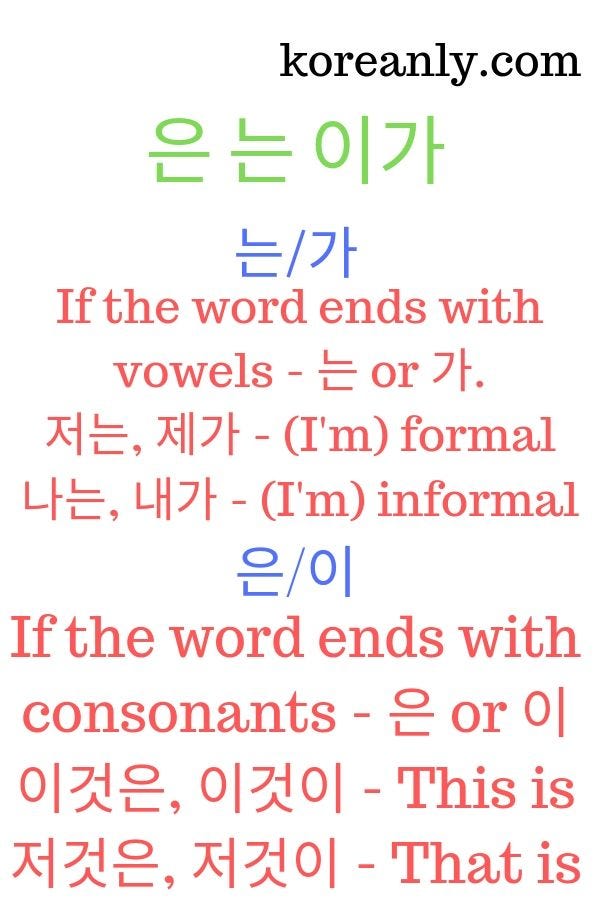
studykorean101 on Tumblr korean particles
If you're one of the millions of Korean learners who have struggled to understand exactly how the Korean particles 은, 는, 이 and 가 work, this will be a great o.

[Korean Grammar] How To Use 은/는 이/가 Subject Particles in a Korean
이 attaches to nouns ending in a consonant and 가 to nouns ending in a vowel. 이 / 가 follow a noun that's the subject of a sentence presenting new information. So this information may not be fact, and may change. If you've ever studied Spanish, think of this like ser vs. estar. 이 / 가 is like estar in Spanish and 은 / 는 is more.

[Learn Korean] Grammar PARTICLES 은 는 이 가 YouTube
To sum it up, 이 and 가 are used to denote the subject of a sentence. • 이 is used after a noun that ends in a consonant. (E.g. 선생님이 / 책이 / 이름이 ) • 가 is used after a noun that ends in a vowel. (E.g. 학교가 / 엄마가 / 의자가 ) Let's look at some example sentences: 신발이 더러워요.

Korean Particles HOW TO Use 은/는, 이/가 and 을/를 Flexi Classes
안녕하세요~! 토미입니다! Today, I will teach you how to distinguish the topic marker 은/는 and the subject marker, 이/가. In Korean grammar, the concept of particles takes an important role in defining the relationship that words have in a sentence. In Korean, you should add a particle right after each main word so that it is easy for the listener to understand.

[korean grammar] Comparing 이/가 vs 은/는 YouTube
Here are some differences you should know when using 은/는 and 이/가! FOCUS ON 이/가 EXAMPLE 1 이/가 is used when talking about new information or something for the first time. 동네에 새로운 식당 이 생겼어요. 그 식당은 인기가 많아요. There is a new restaurant in my neighbourhood. The restaurant is very popular. 지수 가 남자친구와 파티에 왔어요. 남자친구의 이름은 민호예요.

[Advanced] Topic Marker 은[eun]/는[neun] vs. Subject Marker 이[i]/가[ga
Today's goals: Particles (markers) 은/는 and 이/가 are attached to the topic or the subject of a sentence. 은/는 is often referred to as the topic marker, and 이/가 the subject marker. However, in my experience, this differentiation only adds to the confusion for many learners. The topic and the subject are not always easily determined in a sentence.

은는 & 이가 (Subject Marking Particles) Explained
To be short, 이/가 is used mostly to emphasize the very subject the speaker is mentioning. Like, 제이슨이 문을 두드렸어. (Jason knocked the door.) In this sentence, the speaker is emphasizing the fact that it was "Jason", not anyone else, who knocked the door. However, if the speaker put 은/는 in the same sentence like.

in 5 minutes, distinguish between 은, 는, 이, 가 , how to use Eun, 는, Yi, 가
When you want to show contrast or emphasise a noun, you should use 은/는. For example - 품질 이 좋은데 가격 은 너무 비싸요. (Quality is good but the price is too expensive.) Note that we have simplified the rules. There are more complicated rules and explanations but we don't want to confuse you more.

[How To Use 은/는/이/가] Korean Particles! Grammar Time. Do you always get
How to Use 은/는/이/가 ?! Korean Subject & Topic Markers Minji Teaches Korean 민지 티치 코리안 211K subscribers Subscribe 16K 365K views 6 years ago # Basic Korean Lesson 안녕하세요 여러분 ! In order to.

[Korean Grammar] How to distinguish 은/는 and 이/가 YouTube
은 and 는 are the same. 은 is used if the noun preceding it ends in a consonant, and 는 is used for nouns that end in a vowel. This is for ease of pronunciation. Don't believe me? Try switching the rules! For example, 책 (chaeg), which means "book," and 집 (jip), which means "house," both end in consonants, so we use 은 for them:

Difference between 은/는 and 이/가 Korean language learning, Korean
이/가 and 은/는 are two of the most frequently used particles in the Korean language. At the same time, they are usually the most confusing particles for Korean learners. We have another guide to more Korean particles if you wish to dig deeper. Want to Learn Korean? LingoDeer has the Best Korean lessons for self learning Start Now for FREE

Korean grammar — 은/는 이/가. Korean grammar — 은/는 이/가 Definition by
Don't worry. Below we will explain in detail what Korean particles are and provide plenty of examples to help you learn how to use Korean particles in Korean sentences. (FYI - This lesson includes both Korean characters and English romanization.

Learning Korean 01 은/는/이/가 YouTube
Also, 이 / 가 can be used when something is mentioned first and 은 / 는 is used to indicate what you have told. 테이블 위에 사과 가 있어요. 그 사과 는 맛있어 보여요.
N은/는 vs 이/가 = 'topic marker' vs 'subject marker' in Korean yonseikorea
What are Korean Particles? Korean particles mainly function as markers in a sentence. These words help identify what a certain word's role is in the sentence (whether it's the topic or the object), and it also helps connect words to give a clearer meaning to what you want to say.

All Basics about "은, 는 & 이, 가" (Subject Particles in Korean) YouTube
5.1 When to use 이 가 5.2 Difference between 이 가 and 은 는 6 은 는 이 가 을 를 6.1 은 는 (Topic markers) 6.2 이 가 (Subject particle) 6.3 을 를 (Object particle) 7 은 는 difference 8 은 는 이 가 exercise 9 은는이가 연습문제 10 Korean language beginner book 10.1 Important links to learn Korean online Korean grammar 은/는 이/가

Learn Korean 은는이가을를/Korean grammar [4] 은,는,이,가,을,를 YouTube
Rule 2: Comparison. Another difference between 이/가 and 은/는 is that when you are making a comparison, typically in the format of 'A is so-and-so, as for B…' you use the topic marker 는/은. For example if you want to compare the weather between yesterday and today. 어제 비가 왔는데 오늘 은 날씨가 좋다.